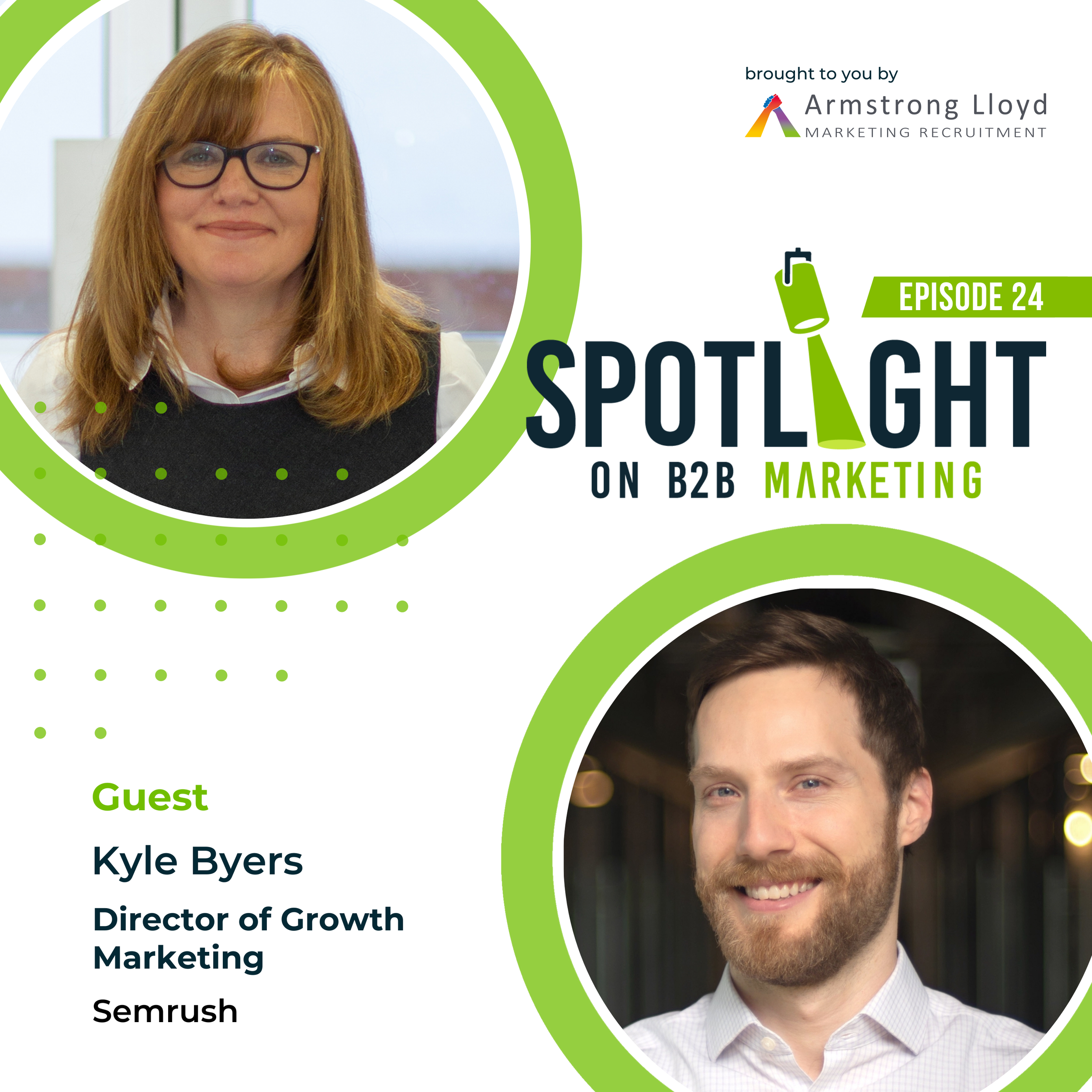Diagnosing What's Wrong in Your Marketing Strategy and How to Fix It
When growth stalls and something feels "off" with marketing, how do you diagnose the real problem? Is it the demand generation engine, the positioning, or something deeper in the business itself?
In this episode of Spotlight on B2B Tech Marketing, host Karen Lloyd sits down with Dani Smallbone, a transformational fractional CMO specialising in turning underperforming marketing functions into strategic growth engines. With experience scaling companies from startup to £40M ARR, Dani shares the diagnostic frameworks she uses to identify what's truly broken and the practical steps to fix it.
From pivoting climate tech companies into new markets to rebuilding demand generation from scratch, Dani reveals the patterns that indicate when transformation is needed versus incremental improvement—and why marketing can never be the sole engine of growth.
LISTEN TO KAREN & DAni
What You’ll Learn in This Episode:
✔️ The telltale signs that indicate a marketing function needs transformation versus incremental improvement
✔️ How to diagnose whether your issue is product marketing, brand messaging, or demand generation
✔️ Why marketing being seen as a service provider rather than strategic partner signals deeper problems
✔️ Real case studies of successful pivots including climate tech and HR tech transformations
✔️ Why growth is a team sport and marketing cannot be the sole engine of success
✔️ How the CMO's role as diplomat and educator drives cross-functional alignment
✔️ The difference between mentoring and coaching for marketing leaders and CEOs
EPISODE OUTLINE AND HIGHLIGHTS
[01:57] The key indicators that a marketing function needs transformation
[04:56] The three-spike diagnostic approach: product marketing, brand messaging, and demand generation
[07:12] When products aren't scalable and what to do about it
[07:35] Case study: Climate tech pivot to high-ACV global customers
[10:19] Case study: HR tech repositioning for different use cases and buyers
[13:35] The importance of mentoring for continuous learning in marketing
[19:16] Why marketing must operate as a strategic, insight-driven function
[20:30] Med tech case study: Linking marketing metrics to commercial outcomes
[22:47] The magic trio: CPO, CRO, and CMO alignment
[26:29] Advice for CEOs: Three questions to ask when something feels wrong
[28:27] Different challenges for early-stage versus established companies
GROWTH IS A TEAM SPORT: WHY MARKETING CAN’T DO IT ALONE
One of Dani's most powerful insights challenges the notion that marketing alone can drive transformation. As she puts it directly: "Marketing cannot be the sole engine of growth. Growth is a team sport."
This perspective emerged clearly in her ClimateTech case study, where the initial diagnostic revealed that the market they were targeting was too limited to support long-term growth due to regulatory barriers. "The overall total addressable market was going to be too small beyond two years worth of ambition," Dani explains.
Rather than simply building better marketing campaigns, the solution required pivoting the entire business model—repositioning the product to target a very small number of global customers with extraordinarily high ACV. This wasn't a marketing fix; it was a business strategy pivot informed by marketing insights.
Similarly, in her HRTech example, transformation required multiple components working together: completely rebuilding the demand generation approach, addressing product differentiation issues, creating distinct brand messaging, and fundamentally changing who they were selling to and how they positioned the solution.
The lesson for CMOs and CEOs alike is clear: when evaluating whether marketing needs transformation, the question isn't just "what's wrong with marketing?" but "what's wrong with the business that marketing can't fix alone?"
FROM VANITY METRICS TO COMMERCIAL IMPACT: REDEFINING MARKETING SUCCESS
Dani challenges marketing teams that celebrate campaign engagement rates and marketing metrics without understanding their connection to commercial outcomes. "They run a great campaign, they have fantastic engagement rates, et cetera, et cetera. But they're not always really truly aligned with commercial outcomes," she observes.
Her med tech case study illustrates this transformation in action. The marketing function was executing well on traditional marketing metrics, but "they didn't really understand how all of those things linked into the commercial strategic objectives of the business."
The solution involved building a comprehensive understanding of how each percentage point improvement at each funnel stage translated to client retention, churn reduction, LTV, and CAC. This shift in thinking—from marketing metrics to commercial metrics—delivered a 20% revenue increase.
But the transformation went deeper. Once the marketing team understood their commercial impact, they could take on a truly strategic role, identifying that the company had maxed out their current market share and needed to explore new territories and products. "The strategic lens of marketing to look at, okay, so what have we got now? What are we really good at? Where could we take this in terms of new product, new territories?"
This evolution from service provider to strategic partner requires CMOs to master the role of "diplomat, politician, advocate, champion, educator"—building the relationships and shared metrics (particularly with the CPO and CRO) that enable true cross-functional growth.
KEY ADVICE FOR CEOS
When CEOs sense something isn't right with marketing, Dani offers three practical steps:
Acknowledge the instinct: "If you're questioning if something's not right, then that's the best starting point. You can't fix something if you don't know you haven't got a problem."
Look for evidence: Do you have a clearer instinct than just a feeling? Is there evidence supporting your concerns? This helps narrow down which area needs exploration.
Assess fundamental alignment:
Is your strategy aligned throughout the business?
Do your teams have the same set of OKRs?
Do you understand how your commercial funnel breaks down step by step?
Are your C-suite leaders collaborating properly?
If any of these areas show gaps or misalignment, it's time to bring in help—whether from board members, CEO networks, or external experts like fractional CMOs.
TODAY’S GUEST
Connect with Dani on LinkedIn
Dani Smallbone is a fractional and interim CMO specialising in helping venture-backed scale-ups build predictable, repeatable growth engines that turn investment into sustainable revenue growth. With over 20 years of experience transforming marketing functions, Dani has helped scale companies from scrappy startups to £40M in annual recurring revenue across B2B SaaS, FinTech, HealthTech, EdTech, and AI sectors.
Dani has held CMO positions at companies including Elliptic (blockchain analytics), HR Duo (AI-powered HR tech), ieso (digital mental health), and served as Divisional CMO at Mind. She also mentors founders and CEOs at Octopus Ventures.
Known for her razor-sharp commercial mind and ability to cut through the noise, Dani focuses relentlessly on driving commercial outcomes rather than marketing vanity metrics—turning underperforming marketing teams into agile, insight-driven growth engines.
OUR HOST
Karen Lloyd is a passionate marketing head-hunter and recruitment expert specialising in marketing and C-suite in the technology sector. With over 25 years of experience in the recruitment industry, Karen brings a unique depth of expertise that sets her apart from most recruiters.
Over her career, Karen has accumulated a wealth of experience that includes serving as a Board Director and being actively involved in growing a business for 13 years. Karen has been a part of five start-ups, giving her first-hand knowledge of the critical importance of hiring the right people.
Currently, Karen is the founder and Director of Armstrong Lloyd. She leads a very special team that partners with businesses and empowers them to build industry-leading marketing teams for some of the most exciting B2B technology brands - from small agile and disruptive start-ups to global giants providing a wealth of product and service offerings.









